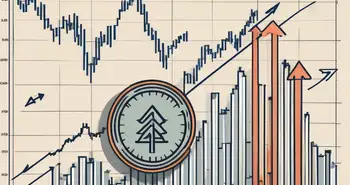The Ultimate Handbook to Buying the Dip

In the world of investing, there is a popular strategy known as “buying the dip.” This approach involves purchasing assets when their prices experience a temporary decline before potentially rebounding. Understanding the concept and factors that influence this strategy is crucial for investors seeking to maximize their profits and minimize their risks.
Understanding the Concept of Buying the Dip
What Does ‘Buying the Dip' Mean?
When we talk about “buying the dip,” we are referring to the practice of purchasing assets, such as stocks or cryptocurrencies, when their prices experience a significant decline. The idea behind this strategy is to take advantage of market fluctuations and buy assets at a lower price, with the expectation that their value will increase in the future.
Buying the dip is often compared to bargain hunting in a sale. Just like how shoppers eagerly wait for discounts to get more value for their money, investors keep an eye out for price drops to enhance their investment portfolios. It requires a keen understanding of market trends and the ability to differentiate between a temporary dip and a long-term decline.
The Psychology Behind Buying the Dip
The decision to buy the dip is influenced by an investor's psychology. Many investors tend to fear market downturns, which can lead to panic selling. However, successful investors view market dips as opportunities rather than threats. They understand that markets are cyclical and that temporary declines are part of the overall upward trend.
It's crucial to mention the concept of “contrarian investing” in this context. Contrarian investors go against the crowd by buying assets when others are selling and vice versa. This strategy requires a strong belief in fundamental analysis and a willingness to swim against the current market sentiment. By staying rational and unswayed by market hysteria, contrarian investors can often capitalize on undervalued assets.
One personal advice I can offer is to develop a long-term mindset when it comes to investing. Instead of being swayed by short-term market fluctuations, focus on the potential long-term growth of your investments. This will help you make more rational decisions and avoid succumbing to fear or impulsiveness.
The Importance of Market Timing
Identifying Market Trends
Market timing plays a crucial role in buying the dip successfully. Identifying market trends can help investors determine the right time to make their purchases. This involves analyzing historical data, monitoring economic indicators, and staying informed about current events that might impact the market.
When analyzing historical data, investors can look for patterns and correlations that may indicate when the market is likely to dip or rise. By studying past market trends, investors can gain valuable insights into potential future market movements. Additionally, monitoring economic indicators can provide a real-time snapshot of the economy's health, allowing investors to adjust their strategies accordingly.
The Role of Economic Indicators
Economic indicators, such as GDP growth, unemployment rates, and consumer sentiment, provide valuable insights into the overall health of the economy. Understanding these indicators can help investors gauge the timing and potential impact of market dips. By keeping track of these indicators, you can make more informed decisions regarding when to buy the dip.
Consumer sentiment, in particular, can be a powerful indicator of market behavior. When consumer confidence is high, it often translates to increased spending and investment, which can drive market prices up. Conversely, low consumer sentiment may signal a potential market downturn. By paying attention to consumer sentiment surveys and reports, investors can gain a better understanding of market dynamics and adjust their timing strategies accordingly.
Risk Management in Buying the Dip
Setting Your Risk Tolerance
Every investor has a different risk tolerance, which refers to their willingness and ability to withstand fluctuations in the value of their investments. When buying the dip, it is crucial to assess your risk tolerance and adjust your investment strategy accordingly. By diversifying your portfolio and setting realistic expectations, you can manage your risks effectively.
Understanding your risk tolerance involves considering factors such as your financial goals, time horizon, and emotional resilience to market volatility. It's essential to strike a balance between taking on enough risk to achieve your investment objectives and avoiding excessive exposure that could lead to significant losses. Conducting a thorough risk assessment can help you make informed decisions and stay committed to your investment strategy during market downturns.
Diversification as a Risk Management Strategy
Diversification is an essential risk management strategy when buying the dip. Spreading your investments across different asset classes, industries, and geographical regions helps reduce the impact of any individual investment's decline. This way, even if some assets experience a dip, others may perform well, balancing out your overall portfolio.
Effective diversification involves more than just spreading your investments thinly across various assets. It requires a thoughtful approach that considers correlations between different investments and aims to build a resilient portfolio that can weather market fluctuations. By diversifying intelligently, you can enhance the stability of your portfolio and potentially improve your risk-adjusted returns over the long term.
Practical Steps to Buying the Dip
Researching Potential Investments
Thorough research is crucial when buying the dip. Evaluate the fundamentals of the assets you are considering, such as their financial health, market position, and growth prospects. Additionally, consider external factors like geopolitical events or regulatory changes that may impact the asset's value. By conducting comprehensive research, you can make well-informed decisions when purchasing during a dip.
Furthermore, it's essential to analyze the historical performance of the asset to understand how it has behaved during previous market downturns. This historical data can provide valuable insights into the asset's resilience and potential for recovery after a dip. By studying past trends, you can better anticipate future price movements and make strategic investment decisions.
Making the Purchase: A Step-by-Step Guide
Once you have identified a potential investment during a dip, it's time to make the purchase. Start by placing your order through a reliable and secure trading platform or broker. Ensure you have sufficient funds available and double-check the price you are buying at. Following these steps will help you execute your investment strategy effectively.
In addition to placing your order, consider setting up stop-loss orders to protect your investment from significant losses. Stop-loss orders automatically sell your asset if its price reaches a predetermined level, helping you limit potential downside risk. By incorporating risk management strategies like stop-loss orders into your investment plan, you can safeguard your capital and minimize losses in volatile market conditions.
Common Mistakes When Buying the Dip
Avoiding Impulsive Decisions
One of the common mistakes investors make when buying the dip is making impulsive decisions driven by fear or speculation. It is crucial to remain calm, stick to your investment plan, and base your decisions on thorough analysis rather than emotions. By avoiding impulsive moves, you can maximize your chances of success when buying the dip.
When faced with a market downturn, it's natural to feel a sense of urgency to act quickly. However, reacting impulsively can often lead to poor decision-making and potential losses. Taking a step back, assessing the situation rationally, and considering the long-term implications of your actions can help you make more informed choices during volatile times.
Overcoming Fear of Market Volatility
Market volatility can be intimidating, especially for novice investors. However, it is essential to overcome the fear of market fluctuations and understand that they are an inherent part of investing. By educating yourself, seeking advice from experienced investors, and staying disciplined, you can build the confidence needed to navigate market dips successfully.
Understanding that market volatility is a normal occurrence can help shift your perspective from seeing it as a threat to viewing it as an opportunity. Embracing volatility as a chance to buy quality assets at discounted prices can be a game-changer for your investment strategy. By reframing how you perceive market fluctuations, you can position yourself to take advantage of market dips and potentially enhance your long-term returns.
Investing is inherently subject to risks and uncertainties. While buying the dip can be a profitable strategy, it is essential to conduct thorough research, analyze market trends, and manage your risks effectively. By adopting a disciplined and informed approach, you can navigate market fluctuations and position yourself for long-term success.
When considering the strategy of “buying the dip,” it's crucial to understand that it involves purchasing an asset after its price has experienced a temporary decline. This approach is based on the belief that the asset's price will eventually recover and potentially increase in value, allowing investors to profit from the rebound. However, it requires a careful assessment of market conditions and a willingness to withstand short-term volatility.
Market timing plays a significant role in the success of buying the dip. Attempting to predict the exact bottom of a price decline can be challenging, if not impossible. Therefore, investors should focus on identifying key support levels, trend reversals, and other technical indicators to make informed decisions. Timing your entry into the market during a dip can enhance your potential returns and reduce the overall risk of your investment.
Ready to put your knowledge of buying the dip into action? Look no further than Morpher, the innovative trading platform that revolutionizes investing with blockchain technology. With Morpher, you can trade a variety of asset classes with zero fees, infinite liquidity, and the flexibility of fractional investing. Whether you're looking to profit from market downturns through short selling or amplify your trades with up to 10x leverage, Morpher offers a unique trading experience tailored for the modern investor. Embrace the future of trading and Sign Up and Get Your Free Sign Up Bonus today to start making the most of market opportunities like buying the dip.

Disclaimer: All investments involve risk, and the past performance of a security, industry, sector, market, financial product, trading strategy, or individual’s trading does not guarantee future results or returns. Investors are fully responsible for any investment decisions they make. Such decisions should be based solely on an evaluation of their financial circumstances, investment objectives, risk tolerance, and liquidity needs. This post does not constitute investment advice.

Painless trading for everyone
Hundreds of markets all in one place - Apple, Bitcoin, Gold, Watches, NFTs, Sneakers and so much more.

Painless trading for everyone
Hundreds of markets all in one place - Apple, Bitcoin, Gold, Watches, NFTs, Sneakers and so much more.









